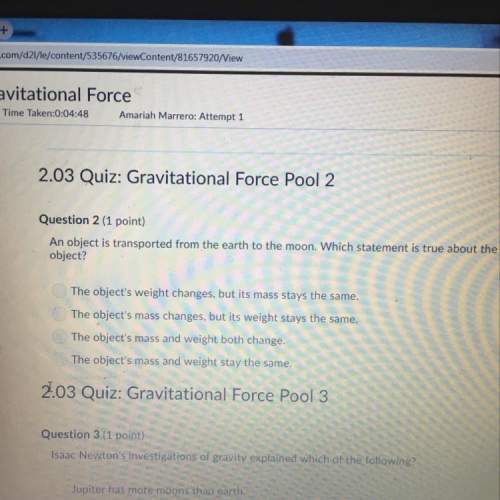
Chemistry, 22.03.2021 19:50 dsanders20
Burning coal that contains sulfur releases sulfur trioxide gas into the atmosphere, where it combines with water to form sulfur and sulfuric acid, thereby producing acid rain. Assume sulfur in coal is in the form of pyrite (FeS2(s)), which reacts with molecular oxygen to produce Fe2O3(s) and SO3(g). Write the balanced equation for this reaction and report the sum of the stoichiometric coefficients, written as integers.

Answers: 3


Another question on Chemistry

Chemistry, 22.06.2019 08:00
Straightforward questions answered in the powerpoint slidesreaction: heating the starting materials under refluxwhat does it mean to heat under reflux? why do we choose water as the reflux solvent? what are boiling chips used for? why do we put a condenser on top of the reaction? why do we add heat and let the reaction stir for 30 minutes? why do we add sulfuric acid to the reaction after it cools as opposed to when it’s still hot? separation: filtration of precipitatewhy don’t we do an aqueous and organic extraction in the separatory funnel? why do you rinse the salicylic acid on the filter with ice cold water? purification: recrystallization of salicylic acid (no hot filtration needed)what is the difference in the amount of room temperature water vs. boiling water needed to dissolve the salicylic acid (assume a 1.2 gram yield of salicylic acid)? remember, in the lab if you need x ml of boiling water to dissolve a solid, then you should add a little more (definitely no more than 1.5 times the theoretical amount) to ensure it doesn’t recrystallize prematurely.analysis: melting point of salicylic acidwhat can you conclude if the melting point of the salicylic acid you just synthesized is 152-155oc and the 1: 1 mix of your product and “synthetic” salicylic acid is 151-154oc?
Answers: 1

Chemistry, 22.06.2019 10:30
Which of these is not an example of chemical weathering? a. iron-rich mineral rusting b. feldspar turning into clay c. limestone reacting with acid d. granite breaking up into sand
Answers: 1

Chemistry, 22.06.2019 20:00
Glucose (c6h12o6) is an important biological molecule. (round the answer to nearest hundredth.) what is the percent by mass of carbon in glucose?
Answers: 2

Chemistry, 23.06.2019 05:00
Match the term to its description match term definition chemical energy a) internal energy caused by vibrations of atoms and molecules electrical energy b) electromagnetic energy that travels in waves radiant energy c) the movement of an electrical charge thermal energy d) potential energy stored in the bonds between atoms
Answers: 1
You know the right answer?
Burning coal that contains sulfur releases sulfur trioxide gas into the atmosphere, where it combine...
Questions


Mathematics, 29.01.2020 21:46



English, 29.01.2020 21:46

Spanish, 29.01.2020 21:46


History, 29.01.2020 21:46

Mathematics, 29.01.2020 21:46




Biology, 29.01.2020 21:46

Physics, 29.01.2020 21:46



Biology, 29.01.2020 21:46







